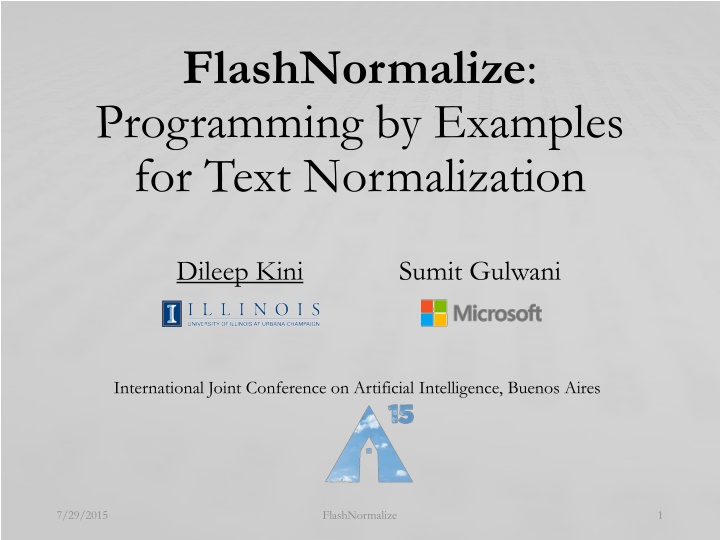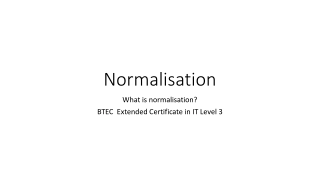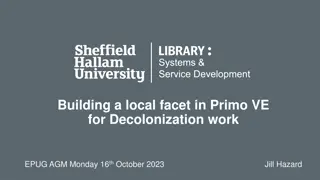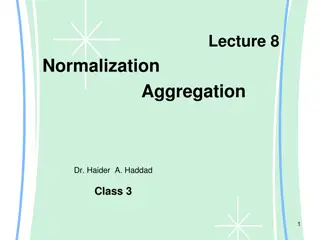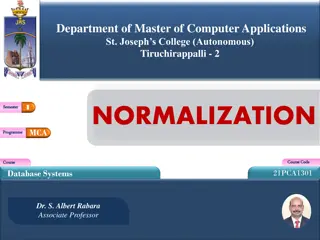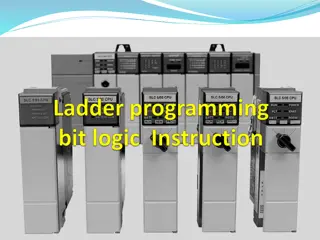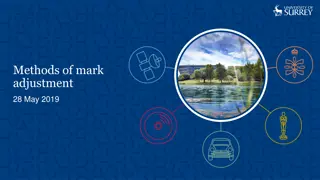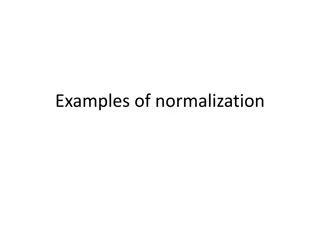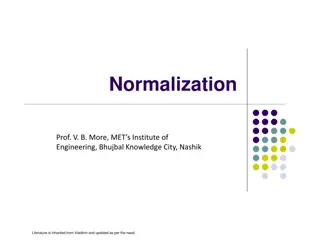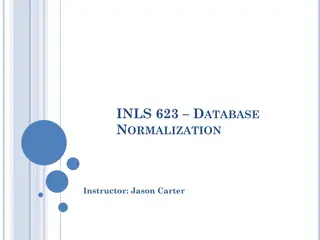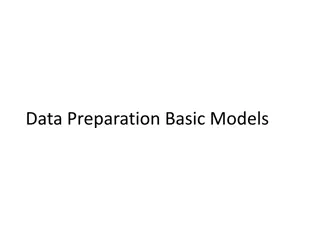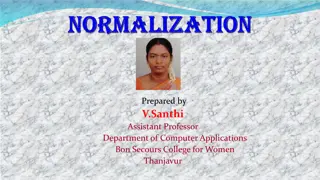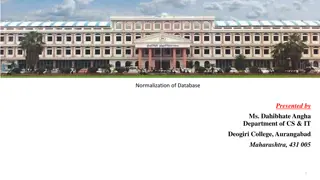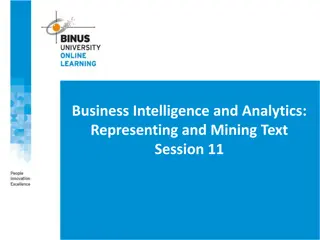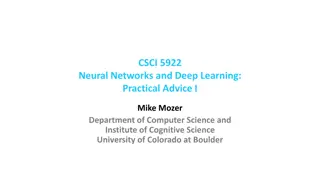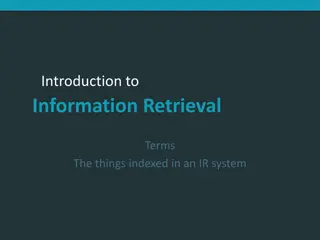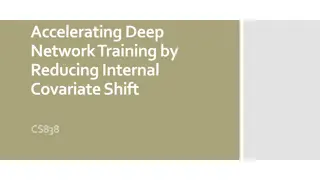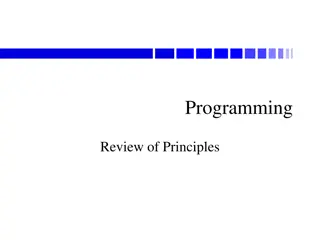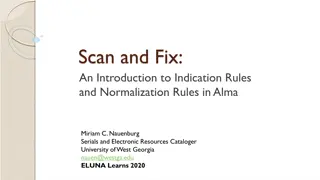FlashNormalize: Programming by Examples for Text Normalization
Text normalization is essential for converting non-standard words like numbers, dates, and currencies into consistently formatted variants. FlashNormalize offers a programming-by-examples approach for accurate normalization, addressing challenges posed by traditional manual methods and statistical techniques. The solution involves learning functions from input-output pairs, providing a domain-specific language for effective transformation.
Download Presentation

Please find below an Image/Link to download the presentation.
The content on the website is provided AS IS for your information and personal use only. It may not be sold, licensed, or shared on other websites without obtaining consent from the author.If you encounter any issues during the download, it is possible that the publisher has removed the file from their server.
You are allowed to download the files provided on this website for personal or commercial use, subject to the condition that they are used lawfully. All files are the property of their respective owners.
The content on the website is provided AS IS for your information and personal use only. It may not be sold, licensed, or shared on other websites without obtaining consent from the author.
E N D
Presentation Transcript
FlashNormalize: Programming by Examples for Text Normalization Dileep Kini Sumit Gulwani International Joint Conference on Artificial Intelligence, Buenos Aires 7/29/2015 FlashNormalize 1
What is Text Normalization? Real text contains Non-standard words (NSWs) : numbers, dates, currencies, phone numbers etc. [Sproat, 2010] Normalization = converting NSWs into contextually appropriate and consistently formatted variants. Applications like text-to-speech, machine-translation, speech- recognition training require Normalization of such words. 7/29/2015 FlashNormalize 2
Typical Tasks Number Translations Input English French Mille deux cent trente-quatre 1234 One thousand two hundred and thirty four Huit cent cinquatre 850 Eight hundred and fifty Soixante-dix-neuf mille 79000 Seventy nine thousand Dates Input Variation Input Output 08/01/2065 Jan 08, 2065 January eighth twenty sixty five 23/04/2006 Apr 23, 2006 April twenty third two thousand six 10/08/1900 Aug 10, 1900 August tenth nineteen hundred 7/29/2015 FlashNormalize 3
Challenges Traditional method: manual programming Scalability: large number of domain/format/language combinations Requires pairing of programmer and language expert Recent techniques: Statistical methods Requires large number of examples Obtained transformation not 100% accurate Our approach in FlashNormalize: Programming-by-Examples Fewer examples 100% Accurate Cannot handle noise in the data 7/29/2015 FlashNormalize 4
Problem Formulation Consider certain functions that take an input string and produces a sequence of strings For dates we need a function that transforms the input string Jan 08, 2065 into January eighth twenty sixty five The specification provided by the user is input-output pairs The goal is to learn a function that is consistent with all the given examples 7/29/2015 FlashNormalize 5
Solution Overview A Programming-by-Examples technology Domain Specific Language The space of possible programs (Concept Class) A program that produces output ?? on each input ?? Input-Output examples ?1,?1, ?2,?2 (??,??) Learning Algorithm 7/29/2015 FlashNormalize 6
Domain Specific Language (DSL) Description of the space of possible programs Decision List: ?? ?,? ?? ?,?? ? ?1 ?2 ?? ?1 ?2 ?? Month(Split(v,0)) ?1 Concatenate Expr: ??= ordered sequence of process expressions (?1, ,??) Ordinal(Trim(Dig(v,0)) ?2 thousand ? Predicate Concat Expr Process Expr: ?? = Table lookup/user defined function applied to substrings of the input ?3 0 ?1,?2,?3,?4 ?2= 0 ?4 0 ?1,?2,?3,? ,?4 ?2= 0 ?1,?2,?3,? 7/29/2015 FlashNormalize 7
Synthesis Algorithm Given a set of input-output example pairs, derive a program from the DSL that is consistent with all the examples. Our algorithm has 2 logically distinct phases A bottom-up learning of process expressions for individual examples A top-down search for decision lists and concats for all examples 7/29/2015 FlashNormalize 8
Learning Decision Lists Let ? be a class of functions, ? be a set of examples Maximal ?-Consistent Cover (?-MCC) for ?: Maximal subsets of ? that are explained by some function in ? Generic Greedy Algorithm for learning ??(?,?): Assumes we know how to: 1. compute Maximal ?-Consistent Cover 2. given ?+,? learn predicate in ? that can separate most examples in ?+ from all examples in ? Algorithm = Iteratively pick subsets of members of ?-MCC that can be separated from the rest of the examples using some predicate in ? How to learn the Concat-MCC for a given set of examples? 7/29/2015 FlashNormalize 9
Learning Concat Expressions Use DAG data-structure for representing concat expressions ?02 ?13 ?23 ?01 ?12 0 1 2 3 edge ??? = set of process exprs that produce the strings indexed ? to ? in the output sequence on the given input A path from 0 to ? represents a concat expr consistent with the example We perform parallel DFS across DAGs for all examples to discover subsets of examples that have a common concat How to find sets of process expressions ??? ? 7/29/2015 FlashNormalize 10
Learning Process Expressions Process exprs are described using a non-recursive grammar string S := B | Substr(B,k,k); string B := v | Split(v,k) | Dig(v,k); int k := -10 | -9 | | 10; We use the Version-Space-Algebra [Lau et al. 2000] to represent sets of programs associated with a non-terminal bucket programs together that behave similarly on the given input use a bottom-up approach to symbolically enumerate these buckets 7/29/2015 FlashNormalize 11
Synthesis Strategies Our learning algorithm requires: 1. A set of representative examples 2. Descriptions of the tables used in process expressions Determining either or both can be challenging! Modularity: Separation of a program into smaller ones which can be reused When a program to be learnt is potentially huge we try learning programs that handle certain parts of the output and use them to learn a complete program Active Learning: for assisting the user find the right examples, and synthesizing tables domain knowledge encoded in the form an algorithm that suggests inputs on which hypothesis program might be wrong Queries: a) Membership b) Equivalence c) Test 7/29/2015 FlashNormalize 12
Evaluation Number Translations: Assume that translating 2-digit numbers is known Learn ?-digit translators for ? = 3 ?? 6. T: #test queries, M: #membership queries E: # examples used in synthesis Tm: time taken in seconds Dl : length of the decision list T M E Tm Dl T M E Tm Dl T M E Tm Dl 27 12 5 .13 2 30 16 6 .14 4 49 41 12 .14 4 Chinese Spanish Russian 50 17 8 .16 3 68 30 12 .19 4 68 44 14 .18 6 90 18 11 .23 4 124 54 20 .43 6 112 43 17 .26 4 183 14 17 .31 5 195 49 24 .73 6 242 72 42 1.6 11 27 12 5 .15 2 26 12 7 .13 2 20 4 4 .13 2 German English 50 15 8 .14 3 43 12 9 .13 3 49 18 8 .14 3 Polish 93 20 13 .20 4 89 21 11 .16 3 89 19 10 .20 3 210 34 27 .41 5 188 42 19 .31 5 180 26 14 .26 3 33 20 8 .12 4 27 13 6 .11 3 27 10 5 .10 2 Portuguese French 65 42 13 .16 6 78 55 18 .21 8 48 15 9 .13 3 Italian 142 57 34 .42 6 93 20 14 .26 4 85 15 8 .15 3 252 112 38 .77 10 191 25 18 .38 4 174 15 17 .28 6 7/29/2015 FlashNormalize 13
Thank You! 7/29/2015 FlashNormalize 14
